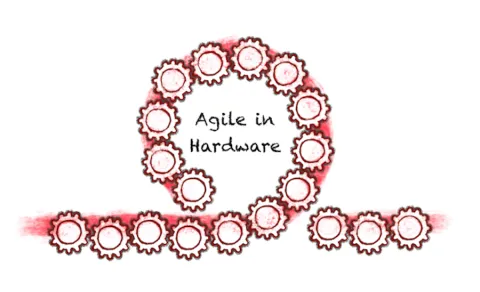Agile Transformation vs. Agile Adoption
Agile transformation, in the end, involves a fundamental shift in how a business operates, encompassing changes to processes, decision-making frameworks, and company culture. The goal is to achieve competitive advantages, increase revenue, productivity, quality, and enhance employee and customer satisfaction. Unlike Agile adoption, which involves implementing Agile practices at the team level without significant structural changes, Agile transformation requires a comprehensive, top-to-bottom approach.
Assess the Current State
Before initiating any changes, it’s crucial to understand the organization’s existing processes, culture, and pain points. This is true in any business change initiative, but in hardware the consequences of failure and impact of changes are greater, and may result in failure of delivery, drop in staff morale, compliance issues, or breaking contractual agreements with suppliers. This assessment helps identify areas that require special attention and ensures that the transformation is tailored to the company’s specific needs as well as identifies areas that, by their nature, have lower flexibility than they do in the software development industry.
- Conduct Interviews and Surveys: Gather insights from employees at all levels to identify pain points and potential quick wins
- Map Existing Workflows: Document current workflows, communication patterns, value streams, and decision-making processes
- Understand Constraints: Identify technological and regulatory constraints that will shape the transformation
- Evaluate Readiness for Change: Assess the organization’s goals and its readiness for Agile transformation
Build Awareness and Obtain Buy-In
A successful transformation requires the support of key stakeholders. Building a strong coalition of decision-makers is essential. The stakeholders need to understand the gravity of the transformation and impact of each decision. To illustrate, in software, bugs or failures can often be patched, and updates deployed relatively quickly, often, without severe consequences. The impact of failure is generally less catastrophic, as software issues can frequently be corrected post-release through patches or updates. Conversely, hardware failures can have significant financial and safety implications. If a hardware component fails after production, the costs associated with recalls, repairs, or redesigns are substantial. The physical nature of hardware means that once a product is in the hands of users, fixing a defect can be prohibitively expensive and damaging to a company’s reputation.
- Educate Stakeholders: Conduct workshops and training sessions to introduce the origin of Agile principles and their benefits. Share success stories from other companies as well is key differences between software and hardware transformations, emphasizing that each transformation is unique
- Engage Leadership: Ensure that leadership understands Agile concepts, as their support will be crucial in maintaining momentum throughout the transformation
Define the Vision and Roadmap
As Seneca the Younger said, “Our plans miscarry because they have no aim.” Setting a clear vision is essential for guiding the transformation. More importantly, aligning the transformation to the enterprise’s mission and identifying risks will ensure that that our best laid out plans do not become rigid and immutable. Since releases of physical products tend to be guided by market events (holiday season, online sales events, industry specific annual conferences etc.,) these often-become fixed milestones, around which the transformation needs to take place.
- Set Specific, Measurable Goals: Align these goals with the company’s strategy and establish Objectives and Key Results (OKRs) to track progress
- Identify Pilot Projects: Start with low-risk areas to demonstrate the value of Agile. For example, implement Scrum or Kanban in a small, cross-functional team to improve collaboration and communication
- Gather Baseline Metrics: Collect existing Key Performance Indicators (KPIs) across teams—such as defect statistics in firmware, design error rates in R&D, or manufacturing yields—to establish a baseline for measuring progress
- Create a Transformation Roadmap: Develop a phased approach with clear milestones and timelines. For instance:
- Phase 1: Form Agile teams and empower them to adapt practices to their context
- Phase 2: Scale up by expanding Agile practices across more teams or departments
- Phase 3: Streamline existing policies and documentation to eliminate bottlenecks
- Phase 4: Anchor new behaviours and practices at the team level
Assemble an Agile Transformation Team
To implement the transformation, you need a dedicated, cross-functional team of change agents. Since transforming physical product development to Agile will require careful risk mitigation there will be element of blending Agile with existing, traditional methodologies. For this reason, growing change agents from local subject matter experts will strengthen the transformation team. Since majority of methodologies and frameworks pertain to software development and related Agile practices, it is not enough to base the Agile transformation on the familiarity with those frameworks. Here, a knowledge of constraints, prioritisation of immutable design elements, and experience of full delivery chain, from concept to operations, has more value.
- Select Experienced Team Members: Include individuals with growth mindset and openness to learning that are ready to become change agents. Familiar with manufacturing, your current business operations, compliance, operations, and digital tools.
- Appoint an Agile Coach: A coach with hands on experience of adapting Agile principles to the context of a business will lead the transformation, train, coach, and mentor your team. The transformation team will initiate and champion the process of bridging the departmental and domain knowledge silos.
- Empower Team Members: Ensure that team members have the authority to make decisions within their areas of expertise.
Start the Transformation and Generate Quick Wins
Agile is about responding to change, so be prepared to adjust your approach as your progress. This will include the level of communication that should match the maturity of the Agile adoption.
- Communicate Regularly: Consider a monthly Agile Transformation Newsletter to share updates, success stories (such as a first ever demo of a potential design), and learning resources.
- Create Learning Opportunities: Establish Agile book clubs, shadowing days, and Communities of Practice (CoPs) to foster a culture of continuous improvement.
Provide Ongoing Training and Support
Due to high impact on business, the transformation is unlikely to be a revolution, and more likely will be a slow-paced evolution. It is common to begin with hybrid approach and blend of practices that ensures stability but allows for progress. A lot of businesses have also adapted approaches to make them bespoke based on experience and learning from past endeavours. Those mustn’t be dismissed since they might be vital to transformation’s success. Along the way, appropriate level of training and education will be need but keeping the momentum and enthusiasm among staff that are at the backend of change curve is equally vital. As the transformation scales, the demand for training and support will grow.
- Develop an Internal Learning Repository: This will help employees understand and adapt to new practices.
- Document New Practices: Create an Agile Playbook to record the practices adopted and adapted to your business context.
- Offer Coaching and Mentoring: Personalized learning opportunities will help embed Agile principles in the organization.
Review and Streamline Processes and Documentation
One of the biggest benefits of Agile is faster decision-making, which requires revisiting and streamlining existing processes. While software can be subject to regulatory requirements, the flexibility of software allows for easier updates and compliance adjustments post-release. Compliance issues, when they arise, are often addressable through software updates, which can mitigate long-term risks.
However, hardware products, particularly those in industries like medical devices, automotive, or aerospace, often face stringent regulatory requirements. Achieving compliance can be more complex and time-consuming, and any change necessitated by Agile practices may trigger additional regulatory reviews and alignment to match the cadence of the feedback iterations.
The complexity and time involved in maintaining compliance with hardware regulations introduce significant risks, especially when attempting to implement Agile practices that emphasize rapid change and iteration.
- Redefine Roles and Responsibilities: Map existing roles to new Agile roles, empowering more decision-makers at all levels.
- Create a Decision-Making Framework: Decentralize and empower decision-makers closest to the work, ensuring quicker and more informed decisions.
- Review and Simplify Documentation: In industries with heavy documentation requirements (e.g., medical devices), ensure that documentation is lean and accessible, reducing administrative overhead.
Sustain and Evolve
After the transformation, focus on stabilizing new ways of working and evolving your processes. One of the greatest gains from the transformation is often the increased speed of decision making, and development due to streamlined processes and better communication. It’s common that the faster delivery is utilized to get more products to the market. It is, however, an opportunity to extend the reach of the transformation as well as introduce more innovation to products for market domination.
- Monitor KPIs: As the transformation matures, rely on KPIs to identify root causes of issues and make informed adjustments.
- Explore Further Improvements: Once the organization has stabilized, consider opportunities for further innovation, such as:
- Modularizing Architecture: Simplify and speed up product development by breaking down complex designs into more manageable modules.
- Adopting Set-Based Design Practice: Modularisation often caries significant investment in hardware development. Set-Based Design is appropriate first step toward modularisation and offers higher quality of decision making.
- Enhancing Automation: Increase efficiency by automating repetitive tasks as teams become more synchronized.
- Investing in Prototyping: Improve the ability to quickly iterate on designs by enhancing prototyping capabilities.
- Strengthening Supplier Collaboration: Bring suppliers closer to the Agile process to improve quality and reduce lead times. Open conversation about relational contracts.
- Updating the Budgeting Process: Make budgeting more responsive to match the pace of Agile development.
Conclusion
Embarking on an Agile transformation in hardware development is a complex and long yet rewarding journey. While the transition from traditional methodologies to Agile presents unique challenges, particularly due to the physical nature of hardware products and stringent regulatory requirements, the benefits of increased flexibility, faster decision-making, and improved product quality make the effort worthwhile. By carefully assessing the current state, securing stakeholder buy-in, and following a structured, phased approach, organizations can successfully navigate this transformation. Continuous learning, ongoing support, and a commitment to evolving practices will ensure that the Agile transformation not only takes root but thrives, positioning companies to achieve greater innovation, efficiency, and market competitiveness in the long run.
Acknowledgments
A big thank you to SAFe SPCs Averil Franklin Stewart and Lars Broden for sharing their experience and providing their perspectives that have contributed to this article.

